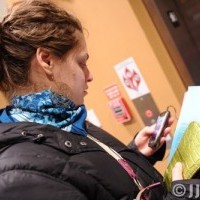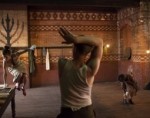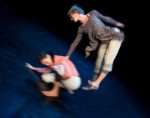Bharata Natyam at Bryn Mawr
By Amelia Longo
After last weekend’s show presented by Sruti, The India Music and Dance Society, I think I could watch Priyadarsini Govind dance with just her eyebrows for an entire evening. Govind’s ability to translate tiny motions into clear expression connected powerfully with the audience, creating a surreal feeling of role reversal -- were we watching Govind, or was she watching us? Equally adept at storytelling through movement and beautiful movement itself, Govind held me enraptured with her Bharata Natyam choreography, a classical South Indian dance based on sculptural poses, and her outstanding live musicians.At times, it felt as if Govind was looking at me directly with her piercing, oft-pleading eyes, and as though her quick intricate changes of facial expression were somehow a reaction to my own. Rather than existing within the world of the performance, she continually reached out to the audience, a compelling reminder that we as witnesses were also part of the story-telling. Her embodiment of being under a lover’s spell -- one finger twirling, eyes and head rolling -- was the only heavy-handed gesture of the evening in my view, yet she conveyed more complex states (sarcasm, awe, and even “Come on, you can tell me!”) quite clearly.
The choreography’s repetition of tiny, expressive, precise movements, interspersed with moments of serene stillness, enabled the audience to ruminate on and fully take in each individual motion, often from multiple angles. Govind alternated shifting just her head and eyes, then just her chest and shoulders. She then turned slowly around in an exquisite circle, presenting the audience with varying views of the same clear, soft twitches from side to side. And of course, the eyebrows -- “flutter” is not a word I would have thought to attribute to an eyebrow movement before this performance.
Govind demonstrated a crisp use of rhythm early on, bending knees outward, rising on the balls of each foot, then thudding her heels in perfect precision with the live Carnatic orchestra. This accompaniment consisted of K.S. Balakrishnan on nattuvangam (cymbals), Gomati Nayagam Ratnam on vocals, Deepu Karunakaran Nair on violin, and Vedakrishnan Venkatesan on mridangam (a double-sided drum). In Nee Matale Mayanura, Govind turned away a false lover with sarcasm and strength -- after a moment of hesitation, she concluded by further blockading the door she’d slammed in his face, emphasizing each bar with quickening firm stomps. Hearing Govind’s ankle bells signifying her return between each piece became thrilling, especially as they heralded her succinct verbal storytelling before performing, giving the perfect amount of context without excessive elaboration.
Govind noted that the exceptionally powerful music accompanying Amba Kamakshi, the central piece of the evening, is rarely danced to and, as such, posed a challenge to visualize and choreograph to. After the music began, the lights came up on Govind seated facing the back of the stage, arms outstretched, fanning out her fingers in a way that resembled shimmering. Joyous little jumps pleasantly punctuated this dance, which otherwise consisted of the small, subtle movements and moments of stillness seen throughout the evening.
The evening ran a bit long for my taste, and I would have preferred some musical interludes to set off the two-hours of Govind’s dancing. But aside from the length and Murugan Krishnan’s sometimes melodramatic lighting, Govind put on an exceptional show full of beautiful dancing and music, intricate emotion, and even humor. The program notes on Bharata Natyam describe the concept of Rasa, “the aesthetic emotion that ultimately transforms the audience.” Indeed, we were transformed.
Sruti presents Priyadarsini Govind, Goodhart Hall at Bryn Mawr College, April 28.
By Amelia Longo
May 9, 2012








